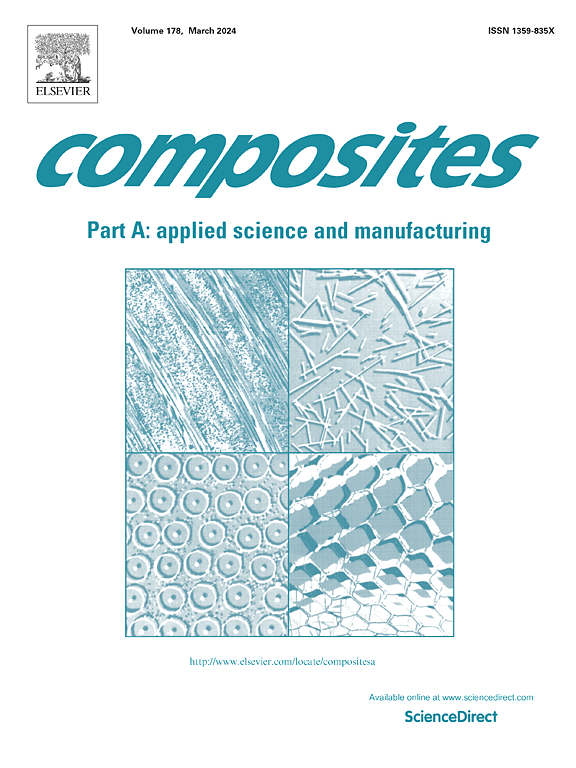聚己二酸丁二酯是一种新型的环氧/玄武岩复合材料的愈合剂
IF 8.1
2区 材料科学
Q1 ENGINEERING, MANUFACTURING
Composites Part A: Applied Science and Manufacturing
Pub Date : 2025-05-06
DOI:10.1016/j.compositesa.2025.109010
引用次数: 0
摘要
这项工作的目的是证明在玄武岩纤维上涂覆热塑性聚合物聚己二酸丁二酯(PBAT)可以实现环氧/玄武岩复合材料的界面愈合。作为参考愈合剂,广泛研究的聚己内酯(PCL)也被用于涂覆玄武岩纤维。将两种聚合物以不同的涂覆速度从聚合物溶液中进行流体涂覆。扫描电镜显示,在低涂层速度下,这两种聚合物的涂层光滑且质量高。在较高的涂层速度下(20mm /s), PCL表现得像牛顿流体,形成液滴状结构。另一方面,PBAT表现得像一种非牛顿剪切稀化流体,在80毫米/秒以上的速度下形成液滴。接触角测量显示,与未涂覆的纤维相比,涂覆两种聚合物的纤维接触角滞后(θH)显著降低,PBAT表现出最低的θH和更光滑的表面。然后将涂层纤维与环氧基结合形成微复合材料,并在微剥离配置下进行测试,以测量界面剪切强度(IFSS)。此外,对PCL和PBAT分别在80°C和120°C下进行30 min的热处理,并通过重复微脱粘测试来评估纤维/基体界面的愈合效率(HE)参数。使用新PBAT涂层获得的HE值高达89.5%,与参考PCL涂层获得的HE值高达93.8%非常相似。综上所述,PBAT涂层在玄武岩纤维增强环氧复合材料中实现界面愈合是一种有希望的替代PCL涂层。本文章由计算机程序翻译,如有差异,请以英文原文为准。
Poly(butylene adipate-co-terephthalate) as a new healing agent for epoxy/basalt composites
The aim of this work was to demonstrate that interfacial healing in epoxy/basalt composites can be achieved by coating basalt fibres with thermoplastic polymer poly(butylene adipate-co-terephthalate) (PBAT). As a reference healing agent, the widely studied polycaprolactone (PCL) was also used to coat the basalt fibres. The two polymers were applied by fluid coating from polymer solutions at different coating speeds. Scanning electron microscopy revealed smooth and high quality coatings for both polymers at low coating speeds. At higher coating speeds (>20 mm/s), PCL behaved like a Newtonian fluid, forming droplet-like structures. PBAT, on the other hand, behaved like a non-Newtonian shear-thinning fluid, forming droplets at speeds above 80 mm/s. Contact angle measurements showed a significant reduction in contact angle hysteresis (θH) for fibers coated with both polymers compared to uncoated, with PBAT exhibiting the lowest θH and a smoother surface. The coated fibers were then combined with an epoxy matrix to form microcomposites and tested in a microdebonding configuration to measure the interfacial shear strength (IFSS). Moreover, the fiber/matrix interface was healed by a 30 min thermal treatment at 80 °C for PCL and at 120 °C for PBAT and healing efficiency (HE) parameter was evaluated by repeating the microdebonding test. With the new PBAT coating HE values up to 89.5 % were obtained, very similar to the HE values of up to 93.8 % achieved with the reference PCL coating. In conclusion, PBAT coating resulted to be a promising alternative candidate to PCL to reach interfacial healing in basalt fibers reinforced epoxy composites.
求助全文
通过发布文献求助,成功后即可免费获取论文全文。
去求助
来源期刊

Composites Part A: Applied Science and Manufacturing
工程技术-材料科学:复合
CiteScore
15.20
自引率
5.70%
发文量
492
审稿时长
30 days
期刊介绍:
Composites Part A: Applied Science and Manufacturing is a comprehensive journal that publishes original research papers, review articles, case studies, short communications, and letters covering various aspects of composite materials science and technology. This includes fibrous and particulate reinforcements in polymeric, metallic, and ceramic matrices, as well as 'natural' composites like wood and biological materials. The journal addresses topics such as properties, design, and manufacture of reinforcing fibers and particles, novel architectures and concepts, multifunctional composites, advancements in fabrication and processing, manufacturing science, process modeling, experimental mechanics, microstructural characterization, interfaces, prediction and measurement of mechanical, physical, and chemical behavior, and performance in service. Additionally, articles on economic and commercial aspects, design, and case studies are welcomed. All submissions undergo rigorous peer review to ensure they contribute significantly and innovatively, maintaining high standards for content and presentation. The editorial team aims to expedite the review process for prompt publication.
 求助内容:
求助内容: 应助结果提醒方式:
应助结果提醒方式:


